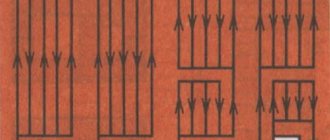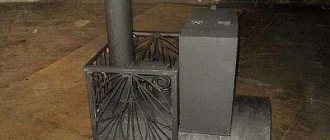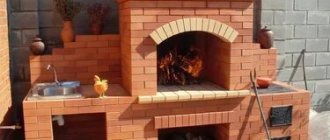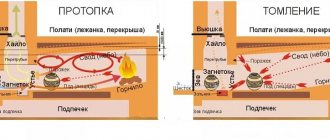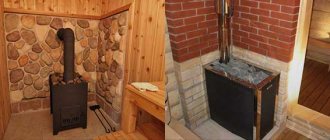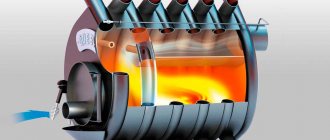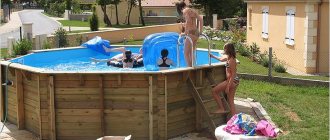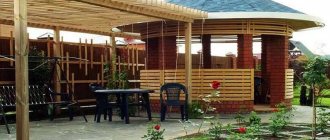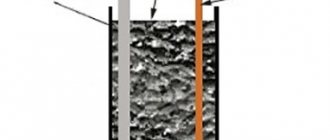A wooden house (dacha), not connected to central heating, needs a heat source that allows it to be lived in at any time of the year. Traditionally, fireplaces or stoves are used for these purposes, which can have a variety of designs.
The order of arrangement of stoves in a wooden house is regulated by current standards (SNiP), and is also specifically stipulated by fire safety requirements.
Furnace designs
Brick kilns have not lost their relevance in the private sector for many years. This is due to their economy and efficiency. The thick walls of the structure can retain heat for a long time.
Stoves are distinguished by purpose and are heating, cooking, combined and multifunctional. We will describe each variety below.
For heating
The most common and simplest. Used for heating only. It is mainly used in houses remote from gas pipelines. It is also often installed as a fireplace stove. These include fireplaces that can have a closed or open firebox, which can effectively heat up to 20 m² of space. Includes a combustion chamber (can be laid out or purchased separately), an ash pan and a chimney.
Stove-fireplace in the country Source pechnoy.guru
Heat transfer depends on the type of masonry, the size of the walls and the materials used. The most popular masonry option is one brick. The walls warm up to 600 degrees. The shape can be elongated, wide, round, triangular. The choice of shape depends on the desires of the home owner, the interior and the area of the room itself. Stone, plaster and tiles are used for decoration.
The easiest way is to make a rectangular or square oven. All other options should be entrusted to a good specialist, since there are many nuances and features of masonry that should always be remembered. To increase the tightness, the stove can be equipped with sheet metal on the outside, which makes it possible to heat large houses.
With hob
A good choice for a summer house that is used in warm weather. The emphasis is not on heating, but on the convenience of cooking. Additionally, a tank for heating water can be installed, which ensures comfortable living. Widely used in homes with heating by electricity or natural gas. The building is made of brick, inside the structure there is a chimney, an ash pit and a firebox. Place a stove on top, you can make an oven.
Option with hob and built-in oven Source gost-kamin.ru
Combined models
Used for cooking and heating at the same time. The project is much more complicated than the previous ones, since it is necessary to make an ash pit, a fuel combustion chamber, a chimney, install a cabinet and a hob. This option is quite heavy and massive, so it is used for spacious houses that require a solid foundation. Used if there is no other heating method. Sometimes they are equipped with drying chambers for preparing various preparations, clothes, and firewood. They are also often equipped with water tanks, beds, and ovens.
Combined stove in the gazebo Source avatars.mds.yandex.net
Multifunction ovens
They are mostly done only in large gazebos. They simultaneously heat the structure and allow you to cook food. As in the previous case, they can have an oven and dryer. The main difference between these ovens is that they can additionally have several more sections for frying food over coals or smoking. Naturally, it is simply impossible to make such a stove yourself without the appropriate skills and knowledge. Therefore, trust the work to qualified craftsmen with extensive experience. This is the only way you will get a good result that will always please you.
Types of furnace equipment for gas movement
The brick warms up well and releases energy into the surrounding space for a long time. But this is not enough for high-quality heating of the kitchen or bedrooms. The heat capacity is increased due to the arrangement of special chambers that promote heating of the walls.
Without going into technical details, the movement of smoke through special channels occurs as follows:
- During the combustion of wood or coal, gases are formed that have an extremely high temperature. Under the influence of physical laws, they rise upward, but are delayed due to obstacles in the form of jumpers and valves;
- smoke begins to spread through the flues, heating the walls;
- the temperature of combustion products decreases. They go into the outlet pipe.
If the channels are laid horizontally, less time is spent on cooling than in analogues with vertical ones. The reason is the low air speed. The inevitable consequence is uneven heating of the rooms.
If we analyze all existing types of stoves, it is preferable to choose units with chimneys laid from the bottom up. No additional effort is required to move the gas. They inevitably move upward and warm up the surrounding space.
But equipment with a vertical chimney is not without its drawbacks. If, in the presence of horizontal channels, the space around the firebox warms up more, then here the heat accumulates in the upper part. The first option is more consistent with fire safety standards.
Another important point concerns furnaces with vertical channels. They should not be too long. The gas passing through them will cool down greatly. The result is uneven heating.
In bell-type heaters, it was possible to partially eliminate the disadvantages associated with heat distribution. Here, separate outlets open into a single chamber. The smoke passes through small-diameter holes and is collected in a hood under the upper ceiling. The combustion products partially cool and fall down. Then they rush into the atmosphere, obeying the natural forces of nature.
In terms of heat capacity, bell-type units are better than their analogues. They are chosen when it comes to heating a house of a large area. If you need to heat a small building at the dacha, a Dutch or Swedish one is enough.
Simple and economical furnace laying
There are several options for how to build a brick oven with your own hands for a house with a stove, step by step and correctly. First of all, you must first determine what the main purpose of the structure is - heating or for cooking. You may choose an option with the additional elements listed above or a direct-flow design. The main thing in resolving this issue is the purpose of the future design.
Design of a small stove Source avatars.mds.yandex.net
Designs with weak gas revolutions do not provide high heat transfer. They are mainly used for small areas - up to 16 m² and garages.
With hob
How to make a stove of this type is described below. The simplest model is small in size - 78x53 cm (WxD) and allows you to place one burner. You can use red brick, but it must be selected very carefully - only smooth and without cracks. This will save on the purchase of fireproof stones.
For the solution, take clay/water/sand (4/1/8 hours). The amount of mortar is determined in accordance with the amount of brick. If the seam is 3-5 mm, then it will be enough for 50 pieces. stones.
The process of laying a slightly smaller stove is as follows:
- A base is prepared that is approximately 10 cm wider than the future structure; the first brick on the base is placed at floor level. With an underground of 0.5 m or more, a hole is not needed.
- Formwork is made 74x61 cm, roofing material is placed on top (in two layers) and concrete is poured. Construction of the structure begins in 7 days and not earlier. It is necessary that the foundation dries well, otherwise the structure will simply sag, may tilt and crack.
Foundation for a stove Source bricks.su
- The depth of the structure is 3 stones, the width is half as much - 1.5 (76x39 cm). The stones are adjusted first without mortar. The layer of mortar for the bottom row is no more than 5 mm.
- On the next tier a hole is left for the blower door. Fastening occurs with wire, its ends are laid in the seams. They leave a gap between the metal and the stone.
- 4 tiers of stones are laid on edge, a firebox is created, and a smoke circulation is created at the back. One stone is placed at the back without using mortar; it must be removed to clean the chamber. Two stands are made in the chimney; they hold the partitions.
- The 5th row is laid flat, leaving a hole for the door, there will be channels at the back.
- From the 8th the door is closed. A brick with a beveled end is placed in the back of the firebox.
- After the 9th tier, a cord (asbestos) is laid, it is used as a sealing material for joints.
- On the 10th, the firebox is covered with a stove.
- Row 11, a valve is placed in the pipe, the pipe is sealed with a cord.
On the next 2 tiers the walls of the pipe are made. How to build a brick oven with your own hands for a house with a small stove - stick to this design and everything will work out. But we must remember that there are a number of nuances and emerging difficulties that need to be resolved immediately. If you make mistakes, you will not get the desired result. Therefore, it is better to contact a specialist.
Ceiling and wall protection in the form of sheathing
In addition to treating elements of wooden structures with fire retardants and mastics, they can be protected from the hot parts of metal furnaces by covering them with fire-resistant materials. When preparing for this procedure, it should be taken into account that the ceiling lining in the area of the roof outlet is carried out only with non-combustible materials that do not spoil the interior of the room.
Important! It is strictly prohibited to use flammable panels for upholstery.
The optimal cladding option is gypsum fiber boards treated with fire-resistant putty. To protect the walls, basalt cardboard can be used, covered with steel sheets on top. Most often, special decorative screens made of stainless steel are used. They not only protect surfaces well from burning, but also look quite aesthetically pleasing.
Another option for protecting walls from hot stove parts involves covering them with bricks placed on edge.
Video description
How to lay a small stove, watch the video:
Direct flow type
There is nothing particularly difficult about how to make a direct-flow furnace. But it is very important to strictly adhere to all requirements and be sure to choose a quality stone.
Used for heating small rooms. A strong foundation is needed. Design dimensions 51x64 cm (WxD).
The arrangement of the furnace is as follows:
- For the foundation, crushed stone is poured into a layer of up to 20 cm and filled with mortar. Each stage must be carefully aligned. You can lay the stone only after a few days.
- The depth of the structure is 2.5 stones, the width is 2. There is no blower chamber; instead, holes are drilled in the door.
- Only the 6th row will cover the door. The general procedure is very simple, you just need to observe the dressing.
- From the 8th row, the structure is narrowed using halves of ¾ pieces of stone. Firebox outlet 12.5x25 cm.
- The 9th row is laid with a whole brick, similar to the 7th.
Laying a direct-flow furnace Source blog-potolok.ru
- The next row is placed edge flush with the inner edge.
- Then again, flat (4 pcs. ¾ and 2 pcs. whole), narrowing the smoke channel.
- Next, the stones are edge-on, there is a brick in the middle of the channel, the structure rises 5 tiers.
All other channels are laid flat. On the last 2, the channel is narrowed in halves to dimensions of 12x12 cm. The valve and pipe are installed last.
See also: Catalog of companies that specialize in the installation of stoves and fireplaces, grill houses and gazebos.
For heating
Let's look at how to build a brick stove for heating. For example, let's take a stove 51cm x 90cm x 2m 38cm (WxDxH).
The following materials will be required:
- sand/clay/brick (18/9 buckets/390 pieces, red, solid);
- doors (cleaning and blowing doors);
- roll of waterproofing roofing felt (60cm x 1m);
- one valve and grid 40x25 cm;
- one pre-furnace steel sheet 70x50 cm.
Brick stove-fireplace for heating Source svoimirukami.lesstroy.net
The masonry process is as follows:
- The base protruding in the first row is laid. Be sure to check the horizontal level with a level. The hardest thing to work with is the corners. It is recommended to install template posts at the corners from bottom to top.
- Two stones with beveled edges are placed at the end.
- The air vent door is installed and secured.
- On the next 2 tiers an ash chamber is made.
- The fire chamber is laid out and a grate is installed.
- The firebox door is placed from the 7th to 8th tiers, beveled bricks are placed at the back (they improve the draft inside the stove).
- At 9 the firebox door is closed.
- The smoke exhaust and fuel chamber are placed from rows 10 to 16.
- The cleaning door is installed on the 17th row.
- Smoke circulation channels are made on 18-30 rows. The walls must be smooth; the inside of the walls must be rubbed with a wet rag.
- On the next two tiers, the roof of the furnace is made.
- The last 2 tiers are laid out for the chimney.
Laying a heating stove Source eurolain.ru
How to make a brick stove for your home with your own hands, if the room is small, is described above. The main thing is to adhere to all requirements and rules. Upon completion of the masonry, the structure must be left to dry. After seven days, a test fire is required.
Economical option
If your budget is limited and the room itself is small, then such a design will be a real salvation. There are many fairly simple designs for economical stoves. You can try making them yourself or order installation. But in any case, you need to understand how to lay a brick stove with your own hands. Even if you don’t do the masonry yourself, knowing how to build a stove will allow you to control all the work.
Heating stove Source i.ytimg.com
Fire safety requirements (FPR)
The PPB requirements stipulate the conditions under which correct installation of any type of furnace equipment is possible. To a greater extent, they relate to the protection of the floor and walls of the building from accidental fire (due to contact of wood with hot surfaces).
The following protective measures will ensure the safety of housing and people:
- The use of special fire-resistant materials that protect the walls and ceiling in the area where the stove and chimney are located (if the house is two-story, the ceiling between floors should also be protected);
- Impregnation of elements of wooden structures bordering the hot parts of the furnace with special compounds.
Compliance with all fire safety requirements and proper use of fire protection equipment is the main condition for the safe operation of home heating equipment.
Video description
For a clear overview of laying and applying mortar, watch the video:
- Duplicate row, but the stones are laid flat.
- The brick is on edge, the walls are wiped with a wet rag.
- The brick is laid flat, and on the back side - on the edge.
- Next, the firebox is closed, 2 bricks should hang over the chamber (if the structure is planned to be used as a fireplace and the firebox is not covered), the flame will be directed to the middle of the structure.
- The stones are moved a little to the back side, they will support the door. Before laying the brick, wet strips of asbestos are laid to seal it. The panel cannot be placed on the mortar - cracks will appear due to the difference in thermal expansion.
- A pipe is formed to remove smoke. A smooth expansion is made towards the back. Stone is used for the base; light metal is used for everything else.
- A valve is installed, it is necessarily sealed with asbestos, first coated with a solution. This completes the construction of the structure.
Decorated stove for cooking and heating Source mainavi.ru
At the end, several tiers of the chimney are made, and a pipe is inserted into it. The brick (installed without mortar) and all debris are removed. The joint of the structure near the floor is closed for decoration with metal. The structure will dry completely after 1-2 weeks.
How to build a simpler type of oven if you don’t have the time, necessary materials or skills? Take advantage of the following structure, which can be erected in just a few hours. It has the simplest operating principle.
Fuel is placed below, which burns there, and where it settles. The draft is created by temperature changes. This design is characterized by a minimal amount of smoke and almost complete combustion of fuel. For this option, two half stones and 20 whole bricks are enough. There are five rows in the stove, the stones are tied together with mortar, but you can lay out the stove without using it - it will be a temporary structure.
About the solution
A solution of clay and sand. The proportions depend on the fat content of the clay. The most common ratio is 1:3. The grind size does not matter.
It’s a good idea to add sheet asbestos soaked in water - it reinforces the clay. It will crack less.
It is better to seal the cracks on heated masonry, previously moistened with water. We fill large cracks with a mortar containing brick fragments or corded asbestos soaked in clay. It can be replaced with a basalt cord. We use the same cord to seal the seams between the tanks (hot water tank, inlet of the heat exchanger-register, etc.) and the brickwork.
First, we clean the cracks from old mortar and soot. Soot is easily removed by rubbing with damp clay. As soon as the clay begins to stick to the brick, it’s normal. Otherwise, there will be no strong connection - soot interferes with the adhesion of the clay. When repairing the hearth and grate seat, the masonry must also be clean.
The design features of a modern stove are constantly being modified and improved, new elements are replacing old ones. But a number of functional details remain unchanged attributes and it is simply unrealistic to do without them. These include grates for ovens. This combustion element of a potbelly stove or fireplace, supporting firewood, coal and fuel briquettes, provides good traction. Through the holes, ash falls down, which makes room for a new fuel load. Cast iron grates of modern stoves can have different designs and are made of various materials, including metal corners.
Advantages of a simple stove
All simple type ovens have many unique advantages. For example, a minimum of time is spent on their construction. Some models can be erected in just an hour, while others take 1-2 days to install. Small structures are lightweight, which means they do not require a foundation, which saves time, money and effort. You can choose any place to install the structure; if mobile versions are made without using a binder solution, then it can be disassembled at any time, moved and installed in a new location. Any materials can be used for fuel - pine cones, logs, stems of large plants, and so on.
Option for decorating a fireplace stove Source o-remonte.com
It is also important that such designs have lower fuel cell consumption. For example, compared to potbelly stoves, you will need several times less firewood. If you use the simplest stove without binding stones with clay, you can increase the heat transfer, which will be greater than from an open fire. This is a great option for hiking, but not very convenient if you travel without transport. Since the brick is heavy and capacious, it is inconvenient and difficult to carry.
An additional big advantage is the minimal level of smoke, and the fuel itself practically burns without waste. After good heating, the temperature of the stones can reach 1 thousand degrees, which guarantees not only good and fast heating, but also quick cooking of various dishes.
Principle of operation
The furnace operates using an energy carrier - fuel, the combustion of which leads to the release of heat. A distinctive feature of the design is maximum efficiency and reduced heat loss. The molds in which the confectionery products are placed are placed in the inner cavity. These can be buns, cakes, pies, bread.
Baking occurs as a result of the movement of confectionery products inside the oven. On an elongated belt, products move at a certain speed and are exposed to different temperatures. Heating can be adjusted externally during operation.
The baker also changes the heating intensity of the heating elements from above and below. When moving products through different compartments, the products are first baked more intensely, then the intensity decreases. This principle allows you to produce baked goods and confectionery products on-line, resulting in a large quantity of high-quality products.
Production process
Do you need a drawing?
Drawings “how to build a stove with your own hands correctly” are not required in this case, especially if a specialist is working. A clear and detailed description allows you to do without them. It is the simplicity of the designs and minimal costs that make it possible to save yourself from complex and lengthy work.
A high-quality and detailed drawing is only necessary if you are building a large stationary stove for heating your home and cooking food. But even in this case, an experienced specialist can do without it.
Multifunctional large oven Source i.ytimg.com
Wood processing
The most common protective agents include special impregnations (fire retardants) and transparent mastics. The following elements of wooden structures are usually processed by them:
- ceiling beams;
- floorboards in the area where the stove is installed;
- walls adjacent to it.
Additional Information! When choosing products, you must keep in mind that mastic has a higher fire protection rating than colorless impregnation.
Fire retardant treatment of wood elements can be carried out not only by representatives of the Ministry of Emergency Situations, but also by the owners of the house themselves. In the second case, they will need to obtain a special certificate confirming the correct installation of the stove.
The opinion of the luminaries
A.I. Shkolnik , a generally recognized authority among modern stove makers, says about this
“ The efficiency of a firebox with a solid bottom , that is, without a blower and grate, does not exceed 35% . The low efficiency of a firebox with a solid bottom is explained by the following reasons. Firstly, excess air, which, without participating in the combustion reaction, passes through the furnace in transit and cools its surfaces. Secondly, the low temperature of the supply air, which does not come into contact with the heat-transfer medium. Thirdly, the air in a firebox with a solid bottom moves above the fuel and not through its thickness.
A firebox with a blind bottom is more difficult to operate than a firebox equipped with a grate, since access to a sufficient amount of air is difficult for the fuel located deep in the fuel volume and the fuel does not burn. In order for the fuel to burn, it must be moved to the front of the firebox. In addition, it is necessary to continuously monitor the fuel combustion process, loosen and move it within the hearth. When loosening the burning layer, doors 2 and 3 have to be opened, which leads to additional cooling of the furnace mass with air.” (A.E. Shkolnik. Stove heating of low-rise buildings. M., 1991, p. 24)
And here are the words of I. S. Podgorodnikov , creator of the first two-bell furnaces, which are now called Kuznetsov furnaces:
“When burning fuel on a blind hearth (i.e. without a grate - my clarification - O.S.), most of the air necessary for combustion passes over the fuel, carrying the heat with it into the chimney ." (I. S. Podgorodnikov. Household two-bell stoves., M., 1992, p. 22)
Normative base
In Russia, the manufacture and use of equipment for public catering establishments, including baking ovens, is regulated by several standards:
- GOST R 50620-93 “Machines and equipment for the baking industry. Safety requirements".
- GOST 26582-85 “Food machines and equipment. General technical conditions".
- GOST 12.2.092-94 “Electromechanical and electric heating equipment for public catering establishments. General technical safety requirements and test methods."
- For rotary baking ovens, on the basis of the European standard EN 1673:2000, GOST R 54320-2011 “Rotary baking ovens” was developed and implemented. Safety and hygiene requirements."
How to properly heat the second floor
Supplying heat to the second floor of a house is a rather difficult task. As an option, you can consider installing a fireplace equipped with additional equipment. The fireplace has a number of advantages. Among them are the following:
- ease of operation;
- small sizes;
- use of almost any fuel.
How to properly heat the second floor
In fairness, it should be noted that most of our people consider it a luxury item, but this design is capable of combining democracy, aesthetic properties, and excellent performance of its main task - heating the room.
Heat supply to the second floor due to air convection. That is, passing by a heated fireplace wall, the air receives thermal energy and continues to move upward through a special box. Warm air is supplied to rooms located on the second floor through air ducts, which must be covered with thermal insulation. This is necessary to minimize heat losses and ensure fire safety.
